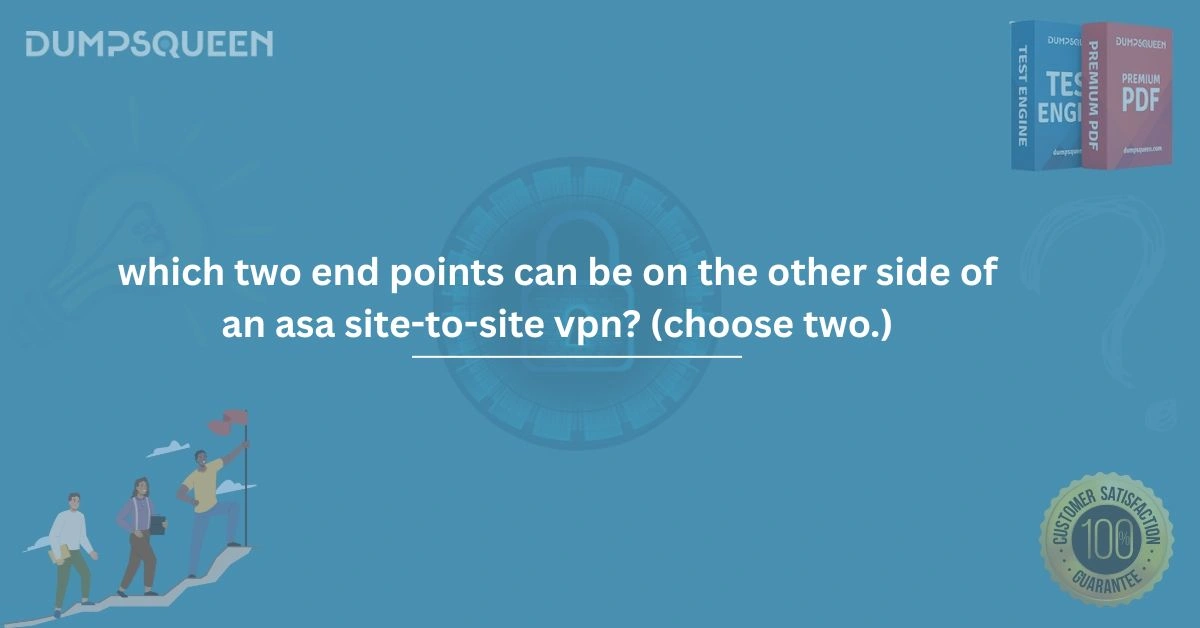Introduction
In the world of modern networking and cybersecurity, the implementation of Virtual Private Networks (VPNs) has become an essential tool for businesses and organizations. One of the most commonly used VPN types is the Site-to-Site VPN, which allows two or more networks to be securely connected over the internet. The Cisco Adaptive Security Appliance (ASA) is one of the most popular devices for setting up and managing Site-to-Site VPNs. When setting up a Site-to-Site VPN using ASA, it's important to understand the various endpoints involved in the VPN configuration. Specifically, this article will explore the question, "Which two endpoints can be on the other side of an ASA Site-to-Site VPN?" We will delve into the details of these endpoints and their significance in ensuring a secure, reliable VPN connection.
What is an ASA Site-to-Site VPN?
A Site-to-Site VPN is a connection between two or more network locations, typically between two business sites or offices. The goal is to securely connect these locations using an encrypted tunnel over the public internet, enabling data to travel between the two sites without interception or tampering. The Cisco ASA (Adaptive Security Appliance) provides robust VPN capabilities, including Site-to-Site VPN. ASA can establish secure tunnels with remote devices or other network devices, including routers, firewalls, and VPN gateways, enabling organizations to protect their internal networks. In a Site-to-Site VPN, there are typically two main types of endpoints involved:
VPN Gateway: The device or appliance that creates and terminates the VPN tunnel. It is responsible for encrypting and decrypting data between the sites.
Remote Device: Any device on the other side of the tunnel that is connected to the remote network, which could be another ASA device, a router, or another network appliance.
Now, let's look at which endpoints can be on the other side of an ASA Site-to-Site VPN connection.
Endpoints on the Other Side of an ASA Site-to-Site VPN
Another Cisco ASA Device
One of the most common endpoints that can be connected on the other side of an ASA Site-to-Site VPN is another Cisco ASA device. When two ASA devices are connected via a VPN tunnel, they create a secure communication channel between two distinct networks. Each ASA device acts as a gateway to the internal network behind it, ensuring encrypted and safe data transfer between the two locations. The ASA devices use standard VPN protocols such as IPSec (Internet Protocol Security) and IKEv2 (Internet Key Exchange version 2) to establish the tunnel. This setup is common in large enterprises that need to securely connect multiple office locations. Benefits of using two ASA devices for a Site-to-Site VPN:High security: Cisco ASA devices are well-known for their advanced security features. Centralized management: Organizations can easily configure, monitor, and manage their Site-to-Site VPN connections from a single interface. Scalability: Adding additional ASA devices to a network for new Site-to-Site VPN connections is straightforward.
2. A VPN Router
Another common endpoint on the other side of an ASA Site-to-Site VPN is a VPN router. A VPN router is typically a routing device that supports VPN protocols, and its primary role is to route data securely between different network locations. VPN routers can act as a gateway to remote networks, ensuring that traffic is properly encrypted and routed through the VPN tunnel. In many cases, businesses use VPN routers when they need a less complex solution than deploying an entire ASA device. VPN routers are often found in smaller branch offices or remote locations where the full functionality of a Cisco ASA device may not be required. Benefits of using a VPN router as an endpoint: Cost-effective: VPN routers are often less expensive than deploying a full ASA device. Easier to deploy: Setting up a VPN router is typically simpler than configuring an ASA device. Suitable for small-scale deployments: VPN routers are perfect for small businesses or remote locations that require secure connectivity without the complexity of a large ASA infrastructure.
3. Firewall with VPN Support
A firewall that supports VPN connections can also act as an endpoint on the other side of an ASA Site-to-Site VPN. Firewalls that support VPN protocols can be configured to terminate VPN tunnels, allowing secure communication between two networks. This setup is common when organizations are looking to integrate their firewall solution with their VPN architecture, ensuring that both security and connectivity are addressed simultaneously. Firewalls with VPN support often have advanced features such as:Deep packet inspection (DPI) to monitor encrypted traffic for potential security threats.Policy based routing to control how traffic is routed through the VPN tunnel. Stateful inspection, which ensures that only legitimate, encrypted traffic can pass through the tunnel.
4. Cloud VPN Gateway
As cloud services continue to grow in popularity, many organizations now extend their networks to cloud environments, where a Cloud VPN Gateway can act as an endpoint for an ASA Site-to-Site VPN. A Cloud VPN Gateway provides secure connectivity between on-premises networks and cloud services like Amazon Web Services (AWS) or Microsoft Azure. Using a Cloud VPN Gateway as an endpoint allows organizations to securely connect their internal network to a cloud-based network infrastructure. This setup is ideal for businesses that are leveraging cloud solutions for their operations, allowing them to integrate their on-premises network with their cloud-based resources seamlessly. Benefits of using a Cloud VPN Gateway: Seamless integration: Securely connect on-premises networks with cloud resources. Scalable infrastructure: Cloud VPN solutions allow businesses to scale their network connectivity as needed. Flexibility: Cloud VPN gateways are adaptable to a wide range of cloud services, ensuring that organizations can use their preferred cloud platform.
Free Sample Questions
1. Which two endpoints can be on the other side of an ASA Site-to-Site VPN?
A) Another Cisco ASA Device
B) VPN Router
C) Switch
D) Web Server
Correct Answer: A) Another Cisco ASA Device, B) VPN Router
What is the main function of a VPN router in an ASA Site-to-Site VPN configuration?
A) To manage VPN encryption keys
B) To route traffic between remote networks securely
C) To connect to the cloud infrastructure
D) To monitor internal network security
Correct Answer: B) To route traffic between remote networks securely
What is the primary benefit of using a Cloud VPN Gateway with an ASA Site-to-Site VPN?
A) It allows secure communication between internal networks and cloud-based infrastructure.
B) It provides advanced security features for on-premises networks.
C) It simplifies network topology for small businesses.
D) It is easier to deploy than a VPN router.
Correct Answer: A) It allows secure communication between internal networks and cloud-based infrastructure.
Security Considerations When Using ASA Site-to-Site VPN
When configuring a Site-to-Site VPN using ASA devices, security is a top priority. Ensure that encryption standards such as AES (Advanced Encryption Standard) and secure key exchange protocols like IKEv2 are used to secure the data tunnel. Additionally, regular monitoring of VPN connections should be conducted to detect and prevent any unauthorized access. Best practices for enhancing security in ASA Site-to-Site VPNs:
-
Use strong authentication methods such as digital certificates or pre-shared keys (PSK).
-
Regularly update ASA firmware to address potential vulnerabilities.
-
Implement access control policies to restrict who can establish VPN connections.
Conclusion
In conclusion, understanding which endpoints can be on the other side of an ASA Site-to-Site VPN is crucial for designing and deploying secure and reliable VPN connections. Cisco ASA devices, VPN routers, firewalls, and Cloud VPN Gateways are all valid endpoints for these types of configurations. By choosing the appropriate endpoint based on your organization’s size, security needs, and budget, you can ensure that your Site-to-Site VPN is both secure and effective. At DumpsQueen, we understand the importance of mastering Cisco and networking certifications to ensure success in today’s digital world. With our detailed study materials and practice exams, you can confidently prepare for certifications such as the CCNA and beyond. If you're ready to take your networking skills to the next level, visit our website at for all the resources you need.




